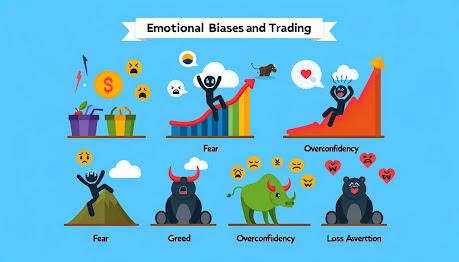Introduction
In the whirlwind world of stock trading, where numbers and charts dominate the landscape, there lies a less tangible yet equally powerful force: the human mind. The psychology of trading is a fascinating journey into the emotional and cognitive processes that underpin every buy or sell decision. This exploration is not just about understanding market trends; it's about delving deep into what makes us tick as traders. What if our stock picks could talk? What would they reveal about our hopes, fears, and aspirations?
At the heart of every trade is a decision influenced by a complex web of psychological factors. From the thrill of a winning streak to the stomach-churning fear of loss, our emotions can both propel us forward and hold us back. But beyond the surface of these emotional tides lies a rich tapestry of psychological biases and personality traits that shape our trading behavior. Whether it's the overconfidence that comes with success or the hesitation triggered by past losses, each trader's psychological makeup plays a crucial role in their approach to the market.
As we peel back the layers of trading psychology, we uncover insights that challenge the conventional wisdom of the markets. It's not just about analytical prowess or having the right information at the right time; it's about understanding ourselves. By recognizing our emotional biases and learning to manage them, we can make more informed, rational decisions. This journey into the psychology of trading is not just about improving our financial outcomes; it's about embarking on a path of self-discovery and growth.
In this blog post, we'll explore the intriguing interplay between human psychology and stock trading. We'll delve into how our emotional biases affect our trading decisions, what our trading style reveals about our personality, and how we can harness psychological insights to become more disciplined and successful traders. So, as you read on, consider what your stock picks might be saying about you. Are they the reflection of a calculated strategist or the echoes of emotional impulses?
Join us at Twisted Finance for more insights that bend the norm, offering a fresh perspective on the financial world. Where finance meets fun, we unravel the complexities of the market with a twist.
Emotional Biases and Trading
In the labyrinth of the stock market, where every decision can lead to triumph or defeat, the battle is not just against market forces but also against our own minds. Emotional biases, the invisible architects of our trading decisions, often guide us in subtle yet profound ways. Understanding these biases is crucial in navigating the market's tumultuous waters with a clear head.
Fear and Greed: These primal emotions are the yin and yang of trading psychology, driving markets to extremes. Fear, manifesting as panic selling during downturns, can lead to missed opportunities as the market rebounds. Greed, on the other hand, tempts traders to ride the bullish wave too long, often resulting in losses when the market corrects. Recognizing these emotions in ourselves and others can provide a strategic advantage, enabling us to act not out of emotion, but from reasoned analysis.
Overconfidence and Loss Aversion: Success breeds confidence, but in the stock market, overconfidence can lead to recklessness. Traders who have experienced a streak of wins may become blind to the risks, exposing themselves to sudden downturns. Conversely, loss aversion, the fear of realizing a loss, can cause traders to hold onto declining stocks too long, hoping against hope for a rebound. Balancing confidence with caution, and accepting that losses are part of the game, are key to long-term success.
The Herd Mentality: Often, traders follow the crowd without questioning the rationale behind a market movement. This herd mentality can inflate bubbles and deepen crashes. Independent thinking, backed by diligent research, can help traders avoid the pitfalls of blindly following the herd.
Anchoring: This bias occurs when traders fixate on specific price points, such as the price at which a stock was bought, influencing their decision-making process. It can prevent adapting to new information, leading to suboptimal trading decisions.
To navigate these emotional waters, traders can adopt several strategies. Maintaining a trading journal can help in identifying personal biases by providing a historical perspective on decision-making patterns. Setting predefined entry and exit points for trades can reduce the influence of emotion, ensuring decisions align with strategy rather than momentary feelings. Finally, continuous learning and self-reflection can enhance emotional intelligence, empowering traders to recognize and counteract their biases.
By understanding and managing these emotional biases, traders can sharpen their edge in the market, making decisions that are informed, rational, and aligned with their long-term goals.
Managing Emotions for Better Trading Decisions
The journey of a trader is not just about mastering the market; it's equally about mastering oneself. Emotions, if not managed properly, can be a trader's downfall, leading to impulsive decisions and deviation from strategy. However, with the right approaches, it's possible to navigate the emotional landscape of trading effectively.
Mindfulness and Meditation: The first step in managing emotions is recognizing them. Mindfulness and meditation can be powerful tools for achieving this awareness. By fostering a state of calm and presence, traders can observe their emotional responses without being overwhelmed by them, allowing for more deliberate and thoughtful decision-making.
Planning and Strategy: A well-defined trading plan acts as a roadmap, guiding traders through market volatility with pre-established entry and exit points. This planning helps minimize emotional decision-making by providing a clear set of criteria for making trades, reducing the temptation to act on impulse.
Discipline and Routine: Discipline is the backbone of successful trading. Establishing a routine that includes regular review of trades, adherence to the trading plan, and continuous learning can reinforce discipline, helping traders stay the course even in the face of market upheavals.
Self-Reflection and Journaling: Keeping a trading journal is an invaluable practice for emotional management. By documenting trading activities, emotions, and outcomes, traders can gain insights into their behavioral patterns and emotional triggers, enabling them to identify areas for improvement.
Seeking Support: Trading can be a solitary endeavor, but it doesn't have to be. Engaging with a community of traders, seeking mentorship, or even working with a coach can provide emotional support and guidance, offering new perspectives and strategies for managing the psychological aspects of trading.







.png)